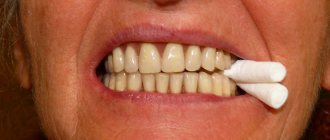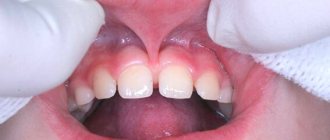Allergic to saxophone?
Did you buy a new lipstick or change your toothpaste? And suddenly my lips were “swept.” What's happened? This is how contact-allergic cheilitis manifests itself. The name itself speaks about the reasons that cause it.
But the culprits of the disease are not only chemicals - sometimes it develops after contact with metal objects. There is even a “professional version” - this type of cheilitis attacks musicians who play wind instruments - the lips react to contact with a metal mouthpiece. Peeling, itching, burning, redness of the lips, and sometimes swelling are unpleasant sensations. The main thing is not to try to get rid of them on your own; you can greatly worsen your condition.
What to do . To find and eliminate the culprit, this most often requires a consultation with an allergist and appropriate examinations to determine the allergen. For treatment, ointments containing corticosteroids, which have antiallergic, antipruritic and anti-inflammatory effects, are used, and antihistamines are also prescribed.
You will also have to watch your diet: give up citrus fruits, strawberries, chocolate, caviar and other foods that can provoke allergic reactions.
Wind and sun are not friends
There is also the so-called meteorological cheilitis, which often develops in those who spend a lot of time in the wind and are often exposed to sudden temperature changes in the air.
And in the southern regions, where the sun shines brightly almost all year round and therefore increases solar radiation, actinic cheilitis is common.
What to do. Lips should be well protected and constantly use hygienic and sun-protective lipstick. And for those who work in the wind, on the street, a special ointment based on lamb fat is suitable, which is no less effective than lipstick.
These two types of cheilitis must be treated promptly and carefully so that they do not gradually become chronic, because against their background, oncological diseases of the lips and oral cavity often rapidly develop.
Another crack?
A serious problem is a crack in the middle of the lip, which is very difficult to get rid of - the inflammatory process is “stimulated” by microbes that get into it, which prevents healing, and the lip in this place often bursts again and again. And this is not only a cosmetic flaw that spoils life - the crack causes pain when talking and eating. The disease can be triggered by injuries, lack of vitamins, smoking and meteorological factors.
What to do . First of all, find the reason that causes the crack to form again and again. And be patient to complete the course of treatment. The doctor will prescribe drugs that have an anti-inflammatory effect and accelerate the formation of epithelium at the site of injury. Sometimes antibiotics are needed.
In extremely difficult cases, they resort to excision of the crack. When the course of treatment is completed, it is important to ensure protection against relapse: use hygienic lipstick, forget about childhood habits: do not lick your lips, do not suck a pencil, do not bite your nails, give up spicy and too hot food.
More about the main pathological prerequisites
As for the pathological problems that lead to the appearance of the symptom in question, most often light discharge occurs due to viral infections, lack of vitamins and microelements, and disturbances in the gastrointestinal tract. Let's take a closer look at the most common reasons for the formation of white plaque on the lips.
Localization of plaque during candidiasis
This type of disease begins to develop against the background of excessive proliferation of opportunistic yeast-like fungi of the genus Candida, which live in every organism. People call this disease “thrush”. Patients with candidiasis often complain of the following symptoms:
- redness of the mucous membrane inside the mouth,
- a cheesy, white coating on the tongue and lips, as well as on the roof of the mouth,
- the appearance of blisters, painful ulcers that cause discomfort during eating and talking,
- sensation of itching and burning at the location of the wounds,
- fatigue, lack of appetite,
- In a newborn baby, plaque often causes an increase in body temperature.
The photo shows candidiasis
. Important! If left untreated, the film acquires a brownish or greenish tint. Therefore, it is better to contact a specialist immediately after discovering a suspicious symptom.
The disease occurs against the background of such negative factors as chronic problems with the gastrointestinal tract, metabolic disorders, diabetes, stress, depression, antibiotic therapy, pathologies of the endocrine system and a sharp decline in immune defense. It is also transmitted to healthy people through kisses, personal hygiene and household items.
Thrush often occurs in women in the first trimester of pregnancy. This symptom disappears on its own, but it is still better for the patient “in pregnancy” to consult a doctor. Candidiasis is also diagnosed during hormonal imbalances, menopause, and during puberty. In a child, sometimes spots are the result of trauma to the mucous membranes and the subsequent formation of pathogenic microflora (if he hits himself or bites his lips).
If left untreated, the film acquires a brownish or greenish tint.
For candidiasis, specialists prescribe treatment, which includes a comprehensive intake of antifungal agents, application of creams and ointments. During the entire course, patients are advised to rinse their mouths with appropriate solutions.
Changes in the oral mucosa due to dysbacteriosis
An imbalance of bacteria (or dysbiosis) in the human body, provoked by taking medications and poor-quality food, often causes the accumulation of deposits on the tongue, similar to cheesy lumps. Plaque is not always easy to clean off from the outer part of the mucous membranes and in some cases has a foamy consistency, which indicates the presence of fungal flora. Characteristics of plaque in dysbacteriosis:
- the thickness of the film does not allow you to see the color of the tongue,
- wet and greasy consistency
- white color (a yellowish tint indicates a more severe form of dysbiosis),
- It can be removed easily, but quickly appears again.
In case of dysbacteriosis, plaque is easily removed, but also quickly reappears.
After carrying out the necessary diagnostic examinations confirming the disease, it is necessary to clean the tongue with special oils and solutions, and also restore the intestinal microflora.
Plaque due to vitamin deficiency
This disease occurs as a result of prolonged malnutrition with a lack of any types of vitamins. The lack of these organic compounds causes a malfunction of the entire body and significantly affects the condition of the epithelium. Dry skin from dehydration cracks, a rash appears on it, and then a plaque forms. Additional symptoms of vitamin deficiency are dulling and falling hair, thin and peeling nail plates, involuntary and painful muscle contractions, bleeding gums, tooth sensitivity, joint pain, decreased visual acuity, weight and slow development of bone mass in the baby.
With autotaminosis, lips become dehydrated, dry and dull.
Depending on the severity of the disease, the doctor prescribes the patient a course of physiotherapeutic procedures, intramuscular injections or oral medication. If all recommendations are followed, clots on the lips of the mouth will disappear very quickly.
Symptoms of stomatitis
Inflammation of the mucous membranes of the mouth, called stomatitis, is characterized by unpleasant, painful sensations when eating or drinking, the appearance of small vesicular blastulas, a light white film and elevated body temperature. In the absence of proper treatment, the patient may develop round purulent ulcers with smooth outlines, the process of salivation will also increase, and the lymph nodes located near the jaw will increase. For the same reason, clots often form inside the lip.
The photo shows stomatitis on the oral mucosa
The infection spreads through contact, therefore, as soon as plaque appears in adults or children, you need to use separate utensils, and place the patient’s toothbrush away from the personal hygiene items of healthy people. This pathological condition is treated under the supervision of a doctor, since the treatment regimen consists of antiviral, painkillers and antibacterial agents.
Problems with lips in diabetes
The disease called diabetes is caused by a malfunction of the pancreas, which is responsible for the production of insulin. Without this hormone, sugar that is not converted into glucose accumulates in the blood, disrupts water metabolism, and fluid is excreted without remaining in the tissues. Therefore, people with diabetes complain of thirst, their skin dries out and peels, and the wounds on it take a long time to heal. Sometimes there is itching and films in the folds surrounding the mouth.
With diabetes, lips crack and do not heal for a long time.
On a note! It is worth noting that against the background of an imbalance in blood sugar, candidiasis, stomatitis and various dental diseases often develop. In this regard, diabetics need to periodically visit the dentist, maintain oral hygiene and monitor their diet.
Symptoms of cheilitis
Problem areas that appear in the corners of the lips often signal the onset of an inflammatory process in the mouth. It develops independently or is a symptom of another disease. Basically, cheilitis can be triggered by dermatosis that accompanies skin pathologies, allergies, or intensive growth of fungal bacteria provoked by taking antibiotics. Also, unbalanced nutrition (with a predominance of foods rich in carbohydrates) and lack of oral hygiene sometimes act as predisposing factors.
With cheilitis, problem areas appear in the corners of the lips
Cheilitis is characterized by dry cracks in the corners of the mouth, followed by the appearance of films on the upper and lower lips. Treatment consists of taking anti-inflammatory, antifungal ointments, antihistamines in combination with hormonal ones.
White film with herpes
One of the very first manifestations of the disease is burning, tingling on the lips and the formation of papules. Over time, the liquid in the transparent blisters becomes cloudy, they burst, turning into a weeping wound, and the damaged epithelium becomes covered with a film. Herpes causes discomfort in people, provokes the growth of lymph nodes and an increase in body temperature. The disease occurs due to a virus that can remain in the body for a long time and manifest itself with the onset of unfavorable conditions such as stress, hypothermia, colds, hormonal imbalance or lack of vitamins.
The photo shows herpes on the lips
Treatment should begin immediately - as soon as bubbles appear. Antiviral and immunomodulatory agents are prescribed as therapy.
Continuous geography
Often, during an examination, the doctor asks: “Show your tongue!”: by its appearance, one can suspect symptoms of a variety of diseases. But the tongue also has its own specific diseases. One of them is desquamative glossitis, in which the surface layer of the mucous membrane begins to peel off, or, as experts say, slough off. As a result, in some areas of the tongue there are no filiform papillae left at all, and they acquire a bright red color, while a light coating appears on the neighboring ones.
How does infection occur?
Most often, infection occurs through close contact with a carrier (hugs, kisses, etc.). At the same time, the carrier himself may not realize that he is a carrier of the infection, since manifestations of the virus (bubble rashes on the mucous membranes) occur when the immune system is weakened, caused, for example, by attacks by ARVI or influenza viruses. A healthy person can become infected with this infection not only through direct contact, but also when using someone else’s personal hygiene items (towel, lipstick, cream, etc.) or utensils that the carrier had recently used. The mechanism of virus penetration into the body is as follows: HSV does not remain on the surface, on the skin or mucous membranes, but is embedded in the DNA of nerve cells, thus remaining “invisible” to the human immune system. That is why there is no medicine that can “stop herpes forever.” This infection becomes noticeable when a person’s general immunity decreases, when the virus goes beyond the nerve cells and begins to multiply. This explains the exacerbation of the disease. It is at this point that the use of antiviral drugs, both local and systemic, is justified.
During the period of virus reproduction, the carrier becomes the most dangerous to others. But this does not mean that any direct contact with an infected person leads to infection of another person. For herpes to enter the body, the following conditions are necessary:
- Damaged skin: with wounds, scratches, cracks, allergic manifestations;
- Contact of mucous membranes with the carrier (kiss);
- Decreased immune defense.
If hair grows in your mouth
Of course, this does not happen, but sometimes it seems that the tongue is covered with... hair. The fact is that thread-like papillae grow on the tongue, and their length can reach one and a half centimeters, and they become like hairs. This phenomenon is observed in cases of impaired immunity, in response to certain medications that disrupt the microflora of the oral cavity, as well as in patients with chronic gastritis and colitis. There is nothing wrong with this, but the patient experiences unpleasant sensations that create constant discomfort.
What to do . If possible, you should stop taking medications and take only antihistamines. After 5–10 days, the “hair” on the tongue will disappear. And don’t forget to brush not only your teeth, but also your tongue twice a day.
Be careful, border!
Oncological diseases of the lips and oral cavity usually creep up unnoticed; all of them can now be successfully treated if you consult a doctor in time. What symptoms should you pay attention to?
Sometimes a malignant formation can cause a harmless-looking spot on the lip. Although it often does not bother you for several months, then an erosion or ulcer suddenly forms, which seems to sink inside the lip and harden.
In men after forty years of age, a wart often appears on the lip, which quickly becomes covered with papillae, becomes horny and lasts for 4–6 months. It is best to remove it as soon as possible.
In general, if you feel any discomfort in your mouth or notice something “suspicious,” do not put off visiting the dentist. Be attentive to yourself!
Herpes on the nose: causes of manifestation and exacerbation
As with herpes on the lips, manifestations in the nasal area are caused by viruses of types 1 and 2. The infection may go unnoticed and appear weeks or even months later.
Typically, an exacerbation of infection is provoked by the following circumstances:
- overheating (on the beach in summer) or hypothermia;
- viral or bacterial diseases;
- unbalanced diet;
- stress, destructive situations;
- alcohol abuse, smoking;
- lack of vitamins;
- exacerbation of chronic diseases;
- long course of antibiotics;
- Women may experience infection during menstruation.









